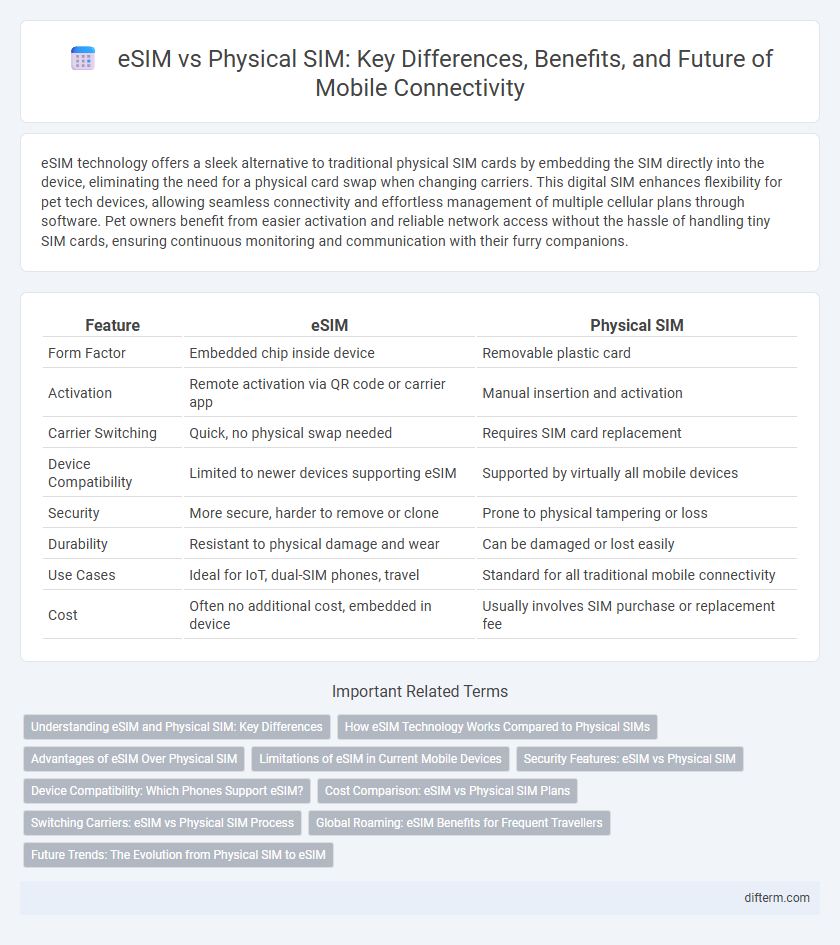eSIM technology offers a sleek alternative to traditional physical SIM cards by embedding the SIM directly into the device, eliminating the need for a physical card swap when changing carriers. This digital SIM enhances flexibility for pet tech devices, allowing seamless connectivity and effortless management of multiple cellular plans through software. Pet owners benefit from easier activation and reliable network access without the hassle of handling tiny SIM cards, ensuring continuous monitoring and communication with their furry companions.
Table of Comparison
| Feature | eSIM | Physical SIM |
|---|---|---|
| Form Factor | Embedded chip inside device | Removable plastic card |
| Activation | Remote activation via QR code or carrier app | Manual insertion and activation |
| Carrier Switching | Quick, no physical swap needed | Requires SIM card replacement |
| Device Compatibility | Limited to newer devices supporting eSIM | Supported by virtually all mobile devices |
| Security | More secure, harder to remove or clone | Prone to physical tampering or loss |
| Durability | Resistant to physical damage and wear | Can be damaged or lost easily |
| Use Cases | Ideal for IoT, dual-SIM phones, travel | Standard for all traditional mobile connectivity |
| Cost | Often no additional cost, embedded in device | Usually involves SIM purchase or replacement fee |
Understanding eSIM and Physical SIM: Key Differences
eSIM technology embeds a programmable SIM directly into a device, eliminating the need for a physical card and allowing seamless carrier switching through software. Physical SIM cards are removable plastic chips that store subscriber data and require manual insertion and replacement for network changes. Unlike physical SIMs, eSIMs enhance device design by saving space, support multiple profiles simultaneously, and provide greater flexibility for global connectivity.
How eSIM Technology Works Compared to Physical SIMs
eSIM technology operates by embedding a programmable chip directly within a device, allowing users to download and activate carrier profiles remotely without inserting a physical card. Unlike traditional physical SIMs, which rely on a removable plastic card containing subscriber information, eSIMs use software-based profiles that facilitate seamless switching between carriers and plans through digital management. This results in faster network provisioning, enhanced security, and greater flexibility for IoT devices, smartphones, and tablets.
Advantages of eSIM Over Physical SIM
eSIM technology offers greater convenience by enabling users to switch carriers or plans without needing a physical SIM card replacement, reducing the hassle and time associated with traditional SIM swaps. It supports multiple profiles on a single device, allowing seamless management of personal and business numbers or travel plans without carrying extra SIM cards. Enhanced security features in eSIMs minimize the risk of SIM card theft or cloning, making them a more secure choice compared to physical SIM cards.
Limitations of eSIM in Current Mobile Devices
eSIM technology faces limitations such as limited carrier support and compatibility issues with older mobile devices, restricting its widespread adoption. Many current smartphones and IoT devices lack built-in eSIM readers, forcing users to rely on physical SIM cards for connectivity. Security concerns and difficulties in transferring eSIM profiles between devices also hinder seamless user experience compared to traditional SIM cards.
Security Features: eSIM vs Physical SIM
eSIM technology offers enhanced security features compared to physical SIM cards by enabling remote provisioning and encryption of user profiles, reducing the risk of SIM swapping and cloning attacks. Unlike physical SIMs, eSIMs are embedded within the device and cannot be easily removed or lost, providing an added layer of protection against theft and unauthorized access. Advanced authentication protocols and secure element integration in eSIMs safeguard sensitive user data, making them a superior choice for secure mobile connectivity.
Device Compatibility: Which Phones Support eSIM?
eSIM technology is supported by a growing number of smartphones, including flagship models from Apple such as the iPhone 13 and later, Google Pixel 4 and newer, as well as Samsung Galaxy S21 and beyond. Most eSIM-compatible devices enable dual SIM functionality, allowing users to switch between physical SIM and eSIM profiles seamlessly. Compatibility also extends to various smartwatches and tablets, enhancing connectivity options across multiple device categories.
Cost Comparison: eSIM vs Physical SIM Plans
eSIM technology reduces costs by eliminating the need for physical SIM cards, lowering manufacturing and distribution expenses for carriers. Physical SIM plans often incur additional fees for card replacement and activation, whereas eSIM plans typically offer more flexible, cost-effective options due to remote provisioning. Consumers benefit from eSIMs through potential savings on international roaming charges and multi-plan management without extra hardware costs.
Switching Carriers: eSIM vs Physical SIM Process
Switching carriers with an eSIM streamlines the process by allowing users to download or activate a new carrier profile digitally without needing a physical card swap. Physical SIM switching requires obtaining a new SIM card, physically removing the old card, and inserting the new one, which can be time-consuming and less convenient. The eSIM's remote provisioning and management capabilities enable faster carrier transitions and seamless multi-network use on compatible devices.
Global Roaming: eSIM Benefits for Frequent Travellers
eSIM technology offers seamless global roaming by allowing frequent travellers to switch between multiple carrier profiles without changing physical SIM cards. This eliminates the need for purchasing local SIMs or dealing with network compatibility issues, ensuring uninterrupted connectivity worldwide. Enhanced flexibility and instant activation make eSIMs the preferred choice for efficient international mobile usage.
Future Trends: The Evolution from Physical SIM to eSIM
The evolution from physical SIM to eSIM signals a transformative shift in mobile connectivity, with eSIM technology enabling seamless remote provisioning and enhanced device interoperability. Future trends indicate widespread adoption as eSIM eliminates the need for multiple SIM cards, supports dual-SIM capabilities in increasingly compact devices, and streamlines carrier switching without physical card replacement. This transition drives innovation in IoT, wearables, and global roaming solutions, positioning eSIM as a cornerstone in next-generation telecommunications infrastructure.
eSIM vs Physical SIM Infographic

 difterm.com
difterm.com